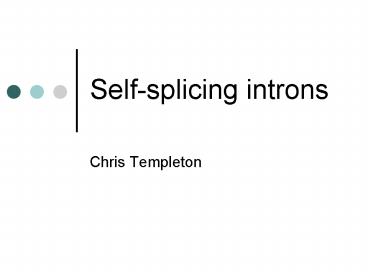Selfsplicing introns PowerPoint PPT Presentation
1 / 24
Title: Selfsplicing introns
1
Self-splicing introns
- Chris Templeton
2
Introduction
- Types of self-splicing introns
- Mechanics of self-splicing
- Mobility of self-splicing introns
- Relevant uses of these introns
3
Introns
- Genes have their coding sequences interrupted by
non coding regions called introns. - These introns must be cleaved to produce a
functional protein, rRNA or tRNA - Self-splicing introns can cleave themselves out
of RNA
4
Self-splicing introns
- Discovered by Tom Cech in 1982 (Nobel Prize 1989)
- It showed that RNA could fold into complex shapes
- Catalyze biochemical reactions
- Provided the mechanistic details for RNA splicing
5
Types of self-splicing introns
- Group I
- Protozoa
- Fungal mitochondria
- Chloroplasts
- Bacteriophage T4
- Some bacteria
- Group II
- Chloroplasts
- Fungal mitochondria
- mRNA of some bacteria
6
Self-splicing introns
- Ribozyme
- An RNA molecule that catalyzes a chemical
reaction - They catalyze their own splicing
- They are self-splicing in vitro but usually
require proteins in vivo.
7
Group I Splicing
5 splice site
3 splice site
Internal Guide sequence
- Occurs in two transesterification reactions
- Free guanosine attacks 5 splice site
- 5 exons 3-OH then attacks the 3 splice site
http//www.mun.ca/biochem/courses/3107/images/VVP/
Ch25/25-23.jpg
8
Group I intron
- G-Binding Site
- Conserved GC pair in P7
9
Converting Group I introns into Ribozymes
- A relinearized intron retains its active site
- 3 G-OH usually attacks a phosphate near the 5
end (upstream of the IGS) in order to cyclize,
but it has been removed so the intron remains
linear. - If G is provided the ribozyme will repeatedly
catalyze cleavage - The IGS can be changed in order to cleave diff.
RNA
10
Group II Splicing
- Occurs in two transesterification reactions
- The 2-OH of a bulged A attacks the 5 splice
site. - The 3-OH of the 5exon attacks the 3 splice
site.
http//www.mun.ca/biochem/courses/3107/images/Lodi
sh/Lod12-20.jpg
11
Group II intron
http//megasun.bch.umontreal.ca/cours/BCM-2002/Pub
lications/Introns-groupII-Bonen2001.pdf
12
Mobility of Group I Group II introns
- Catalytic intron RNA
- ORF (open reading frame) within the intron
- IEP (intron encoded protein)
- Stabilizes the catalytic active RNA structure
- RT activity
- Endonucleases
- Maturases (endonuclease/RT activity)
13
Maturases in yeast mtDNA
- Encoded in the ORF of the intron
- Splice the intron that encodes them
- Group I II maturases have a site-specific
endonuclease activity that mediate intron
mobility.
14
Mobility of Group II introns
- After translation the maturase associates with
the excised intron to form a Ribonucleoprotein
(RNP) complex - Group II introns can be inserted directly into
target sites in double stranded DNA - IEP that has RT, RNA splicing and endonuclease
activity mediates the process
http//megasun.bch.umontreal.ca/cours/BCM-2002/Pub
lications/Introns-groupII-Bonen2001.pdf
15
Mobility of Group II introns
- Introns achieve site specific insertion (homing)
via endonucleases encoded within the intron - Each intron-encoded endonuclease cleaves at a
different target sequence - The intron is inserted into intron- alleles.
http//megasun.bch.umontreal.ca/cours/BCM-2002/Pub
lications/Introns-groupII-Bonen2001.pdf
http//www.sciencemag.org/cgi/reprint/289/5478/452
16
Reverse splicing
http//www.sciencemag.org/cgi/reprint/289/5478/452
- Has been demonstrated in vitro for Group I and
Group II introns - Ribonucleoprotein (RNP) complex recognizes
specific sequences - Intron binds to the DNA using its 3-OH tail
http//megasun.bch.umontreal.ca/cours/BCM-2002/Pub
lications/Introns-groupII-Bonen2001.pdf
17
Reverse splicing
- The opposite strand is cleaved
- The 3 end of the cleaved strand is used as a
primer to reverse transcribe the inserted intron
RNA - The spliced RNA intron serves as a template for
RT - The single stranded cDNA is then incorporated by
recombination or repair mechanisms
http//megasun.bch.umontreal.ca/cours/BCM-2002/Pub
lications/Introns-groupII-Bonen2001.pdf
18
Retargeting introns to specific sites
- Group II introns can be retargeted to different
regions in order for gene therapy - For example
- CCR5 the co-receptor on T-cells which is used by
HIV-1 - Individuals with mutations in CCR5 are resistant
to HIV-1 and have no other pathologies
19
Group II introns designed to insert into
therapeutically relevant DNA target sites in
human cells
- Huatao Guo, et al.
- Science 289, 452 (2000)
20
Human therapy uses
- HIV-1 provirus DNA and CCR5 have been targeted in
order to disrupt their synthesis - The exon binding sites on the intron were
modified and a new sequence for the IEP was
developed
21
Retargeting of intron
- All of the retargeted introns inserted at
precisely the correct position in HIV-1 and CCR5
(confirmed by sequencing) - Intron insertion frequency ranged from 0.16 to
66
22
- PCR, restriction enzyme analysis and sequencing
confirmed that the retargeted introns had
inserted at the correct locations
http//www.sciencemag.org/cgi/reprint/289/5478/452
23
Results
- Group II introns can be retargeted to insert
efficiently into desired DNA target sites - The RNP does retain activity in human cells
- Enrich of the most efficient introns to use for
experiments - This technique could possibly be used for other
diseases
24
Conclusion
- Group I II introns are ribozymes
- RNA intron forms a 3 structure which allows them
to self splice - The spliced intron can retrohome into specific
sites using sequences on intron and Maturase - This technique can in the future be used for
human therapy, genetic engineering and genetic
knockout
25
References
- Bonen, L., Vogel, J, Trends in Genetics Vol. 17
No. 6 2001 - Cech, T. Annu. Rev. Biochem. 1990. 59543- 68
- Saldanha, R., et al. FASEB Journal Vol. 7 1993
- Lambowitz, A., Zimmerly, S. Annu. Rev. Genet.
2004. 381-35 - Molecular Biology of he Gene 5th ed.
- http//www.mun.ca/biochem/courses/3107/Topics/Spli
cing.html
26
Questions

